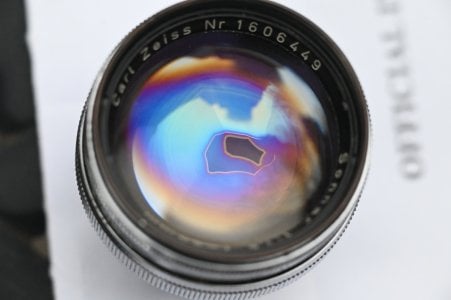MarkWalberg
Established
Bought a 50 mm f1.5 Sonnar on eBay, said to have a little spec.
Looks like more than a spec. This pattern is not on the surface, but is deeper in the lens.
I suspect balsam separation, but would appreciate confirmation from those who know.
Except for this, it is otherwise in great shape. I suppose, with a lot of work, it could be fixed.
Thanks for any advice.
-Mark Walberg
Looks like more than a spec. This pattern is not on the surface, but is deeper in the lens.
I suspect balsam separation, but would appreciate confirmation from those who know.
Except for this, it is otherwise in great shape. I suppose, with a lot of work, it could be fixed.
Thanks for any advice.
-Mark Walberg
Attachments
lukx
Well-known
Yes this is balsam separation, and a pretty severe case at that. It looks like the elements have almost completely separated. Stay away or return if possible. The later west-German Sonnar lenses labelled Carl Zeiss instead of Zeiss Opton were very prone to balsam separation. They changed the glue at some point, and the new glue aged badly as we now know. The earlier Zeiss Opton lenses were only rarely affected.
It can theoretically be fixed by fully separating the elements, removing all the glue/balsam, and reglueing the elements. But in practice you'll have problems aligning the elements properly, applying the right amount of balsam and so forth. Also, I don't know what glue they used and how to remove it. It's not Canada Balsam as used for many years before, which is soluble in Xilene. Quite the DIY project. If the lens was very cheap it might be worth a shot, but only then in my opinion.
It can theoretically be fixed by fully separating the elements, removing all the glue/balsam, and reglueing the elements. But in practice you'll have problems aligning the elements properly, applying the right amount of balsam and so forth. Also, I don't know what glue they used and how to remove it. It's not Canada Balsam as used for many years before, which is soluble in Xilene. Quite the DIY project. If the lens was very cheap it might be worth a shot, but only then in my opinion.
milescl
Well-known
These are fairly ubiquitous and inexpensive. Best to return and buy a better example. Lukx is correct, the later “Carl Zeiss” lenses don’t use Canada balsam and are trickier to correct.
MarkWalberg
Established
Thanks very much. If it doesn't involve a screwdriver, I am not likely to try to fix it myself.
As stated- is a failure of the synthetic cement used by Zeiss on their later Sonnars. Needs an expensive fix, or a cheap Hack if the lens was dirt cheap. Best to return it. On one of my lenses bought dirt-cheap, I used index matching oil, like that used in oil immersion lenses to get rid of Newton's rings. 20 years later, lens is still usable.
Share:


